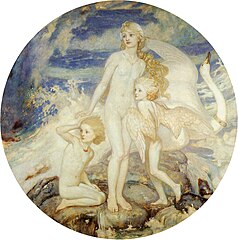The Story of the Children of Lir
The story of the Children of Lir is one of Ireland’s most beloved legends. It has been passed down for generations, capturing listeners’ hearts with its mix of love, magic, and sorrow.
At its core, the tale is about the unbreakable bond of family and the resilience of the human spirit in the face of suffering.
It also reflects Ireland’s deep connection to nature, with the swans becoming symbols of grace and endurance.
One reason this story is so enduring is its emotional depth. It’s a tale of love—between a father and his children and among siblings—tested by betrayal and loss.
The children’s magical transformation into swans is beautiful and heartbreaking, making the story both enchanting and bittersweet.
The Children of Lir also carries layers of meaning. Some see it as a reflection of life’s struggles and the importance of faith and hope, even in the darkest times.
Others believe it represents Ireland’s transition from its ancient pagan traditions to Christianity. The ending, where the children find peace through baptism and pass into the afterlife, suggests influence from the Roman Catholic Church, which became deeply rooted in Ireland’s culture.
This blending of Irish mythology with Christian elements makes the tale uniquely Irish—a bridge between the old and the new.
Whether you’re drawn to its magical swans, its message of endurance, or its connection to Irish heritage, the story of the Children of Lir continues to inspire and move people to this day.
Now, let’s dive into this unforgettable tale.

The Children of Lir: A Tale of Love, Jealousy, and Transformation
Long ago, in the mystical world of the Tuatha Dé Danann, there lived a nobleman named Lir, a powerful figure who loved his family above all else.
Lir had four beloved children: Fionnuala, the eldest and wisest; her younger brothers, Aodh, Fiachra, and Conn.
They lived in peace and happiness in their grand home, surrounded by lush forests and sparkling lakes.
Aoife and the Children’s New Life
Lir’s joy turned to sorrow when his wife, Aobh, passed away. She was the daughter of King Bodb Derg, the ruler of the Tuatha Dé Danann.
In his grief, Lir turned to Aobh’s family for support. To mend his broken heart and ensure the children had a loving caretaker, King Bodb suggested that Lir marry Aobh’s sister, Aoife.
Aoife was beautiful and intelligent; at first, she treated the children with kindness and care.
However, as time passed, jealousy began to poison her heart. She envied the deep bond between Lir and his children, wishing for his love and attention to focus solely on her.
Aoife’s Cruel Plan
Driven by jealousy, Aoife devised a wicked plan to rid herself of the children.
One day, she suggested taking them on a journey to visit their grandfather, Bodb Derg. Excited for the trip, the children eagerly joined her.
Along the way, Aoife stopped at a serene lake. As the children played in the water, she cast a terrible spell with her magical powers.
In an instant, Fionnuala, Aodh, Fiachra, and Conn were transformed into four majestic white swans.
Horrified at what she had done, Aoife regretted her actions but was too proud to undo the curse.
Instead, she added one mercy: the children would retain their voices and their minds, and their songs would be so beautiful that anyone who heard them would be moved to tears.
However, they were doomed to spend 900 years as swans: 300 years on Lough Derravaragh, 300 years on the Sea of Moyle, and 300 years on the waters of Inis Gluaire.
When Bodb Derg learned of Aoife’s betrayal, he was enraged. He stripped her of her powers and transformed her into an air demon, condemning her to wander the earth forever.
The Swans’ Long Years of Sorrow

For the first 300 years, the children lived on Lough Derravaragh, finding comfort in each other’s company. Their sorrowful songs echoed across the lake, drawing people from afar to hear their haunting melodies.
The next 300 years were spent on the Sea of Moyle, a cold and stormy stretch of water. Here, they faced relentless storms and icy winds, enduring their suffering together.
The final 300 years were spent on the waters of Inis Gluaire. By this time, the world had changed. The old gods were fading, and Christianity had spread across Ireland.
The swans, weary from their long journey, continued to sing, their songs carrying tales of their ancient world.
Freedom and the End of the Curse
Their salvation came when a kind monk named Saint Mochaomhóg discovered the swans. He recognized their true nature and blessed them.
The curse was broken, and the swans returned to their human forms. However, they were no longer young and vibrant—they had aged into frail, elderly figures.
Knowing their time was short, the children of Lir asked to be baptized. Together, they passed away and were laid to rest, finally free to join their loved ones in the Otherworld.
Why Story of the Children of Lir Endures
The tale of the Children of Lir is a deeply moving story of love, loss, and resilience. Aoife’s jealousy, the children’s endurance, and the ultimate triumph of love and faith reflect universal themes that have resonated through the centuries.
What do you think of this legend? Have you encountered other stories of transformation in mythology? Share your thoughts in the comments below!
